3.5: Solve Uniform Motion Applications
- Last updated
- Jan 6, 2020
- Save as PDF
- Page ID
- 30384
( \newcommand{\kernel}{\mathrm{null}\,}\)
Learning Objectives
By the end of this section, you will be able to:
- Solve uniform motion applications
Note
Before you get started, take this readiness quiz.
- Find the distance traveled by a car going 70 miles per hour for 3 hours.
If you missed this problem, review Exercise 2.6.1. - Solve x+1.2(x−10)=98.
If you missed this problem, review Exercise 2.4.7. - Convert 90 minutes to hours.
If you missed this problem, review Exercise 1.11.1.
Solve Uniform Motion Applications
When planning a road trip, it often helps to know how long it will take to reach the destination or how far to travel each day. We would use the distance, rate, and time formula, D=rt, which we have already seen.
In this section, we will use this formula in situations that require a little more algebra to solve than the ones we saw earlier. Generally, we will be looking at comparing two scenarios, such as two vehicles traveling at different rates or in opposite directions. When the speed of each vehicle is constant, we call applications like this uniform motion problems.
Our problem-solving strategies will still apply here, but we will add to the first step. The first step will include drawing a diagram that shows what is happening in the example. Drawing the diagram helps us understand what is happening so that we will write an appropriate equation. Then we will make a table to organize the information, like we did for the money applications.
The steps are listed here for easy reference:
USE A PROBLEM-SOLVING STRATEGY IN DISTANCE, RATE, AND TIME APPLICATIONS.
- Read the problem. Make sure all the words and ideas are understood.
- Draw a diagram to illustrate what it happening.
- Create a table to organize the information.
- Label the columns rate, time, distance.
- List the two scenarios.
- Write in the information you know.

- Identify what we are looking for.
- Name what we are looking for. Choose a variable to represent that quantity.
- Complete the chart.
- Use variable expressions to represent that quantity in each row.
- Multiply the rate times the time to get the distance.
- Translate into an equation.
- Restate the problem in one sentence with all the important information.
- Then, translate the sentence into an equation.
- Solve the equation using good algebra techniques.
- Check the answer in the problem and make sure it makes sense.
- Answer the question with a complete sentence.
Example 3.5.1
An express train and a local train leave Pittsburgh to travel to Washington, D.C. The express train can make the trip in 4 hours and the local train takes 5 hours for the trip. The speed of the express train is 12 miles per hour faster than the speed of the local train. Find the speed of both trains.
Solution
Step 1. Read the problem. Make sure all the words and ideas are understood.
Draw a diagram to illustrate what it happening. Shown below is a sketch of what is happening in the example.


Create a table to organize the information. Label the columns “Rate,” “Time,” and “Distance.” List the two scenarios. Write in the information you know.
Step 2. Identify what we are looking for.
We are asked to find the speed of both trains. Notice that the distance formula uses the word “rate,” but it is more common to use “speed” when we talk about vehicles in everyday English.
Step 3. Name what we are looking for. Choose a variable to represent that quantity.
Complete the chart Use variable expressions to represent that quantity in each row. We are looking for the speed of the trains. Let’s let r represent the speed of the local train. Since the speed of the express train is 12 mph faster, we represent that as r+12.
r= speed of the local train r+12= speed of the express train
Fill in the speeds into the chart.

Multiply the rate times the time to get the distance.

Step 4. Translate into an equation.
Restate the problem in one sentence with all the important information. Then, translate the sentence into an equation.
- The equation to model this situation will come from the relation between the distances. Look at the diagram we drew above. How is the distance traveled by the express train related to the distance traveled by the local train?
- Since both trains leave from Pittsburgh and travel to Washington, D.C. they travel the same distance. So we write:
Step 5. Solve the equation using good algebra techniques.
| Now solve this equation. |
So the speed of the local train is 48 mph. |
| Find the speed of the express train. |
he speed of the express train is 60 mph. |
Step 7. Answer the question with a complete sentence.
The speed of the local train is 48 mph and the speed of the express train is 60 mph.Try It 3.5.2
Wayne and Dennis like to ride the bike path from Riverside Park to the beach. Dennis’s speed is seven miles per hour faster than Wayne’s speed, so it takes Wayne 2 hours to ride to the beach while it takes Dennis 1.5 hours for the ride. Find the speed of both bikers.
- Answer
-
Wayne 21 mph, Dennis 28 mph
Try It 3.5.3
Jeromy can drive from his house in Cleveland to his college in Chicago in 4.5 hours. It takes his mother 6 hours to make the same drive. Jeromy drives 20 miles per hour faster than his mother. Find Jeromy’s speed and his mother’s speed.
- Answer
-
Jeromy 80 mph, mother 60 mph
In Exercise 3.5.4, the last example, we had two trains traveling the same distance. The diagram and the chart helped us write the equation we solved. Let’s see how this works in another case.
Example 3.5.4
Christopher and his parents live 115 miles apart. They met at a restaurant between their homes to celebrate his mother’s birthday. Christopher drove 1.5 hours while his parents drove 1 hour to get to the restaurant. Christopher’s average speed was 10 miles per hour faster than his parents’ average speed. What were the average speeds of Christopher and of his parents as they drove to the restaurant?
Solution
Step 1. Read the problem. Make sure all the words and ideas are understood.
Draw a diagram to illustrate what it happening. Below shows a sketch of what is happening in the example.

Create a table to organize the information.
Label the columns rate, time, distance.
List the two scenarios.
Write in the information you know.
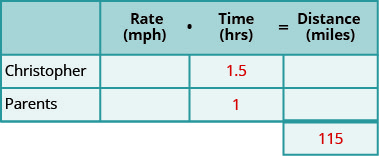
Step 2. Identify what we are looking for.
We are asked to find the average speeds of Christopher and his parents.
Step 3. Name what we are looking for. Choose a variable to represent that quantity.
Complete the chart.Fill in the speeds into the chart.
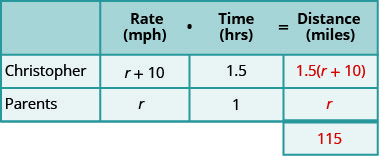
Multiply the rate times the time to get the distance.
Step 4. Translate into an equation.
Restate the problem in one sentence with all the important information. Then, translate the sentence into an equation. Again, we need to identify a relationship between the distances in order to write an equation. Look at the diagram we created above and notice the relationship between the distance Christopher traveled and the distance his parents traveled.The distance Christopher travelled plus the distance his parents travel must add up to 115 miles. So we write:

Step 5. Solve the equation using good algebra techniques.
1.5(r+10)+r=1151.5r+15+r=115Now solve this equation.2.5r+15=1152.5r=100r=40so the parents' speed was 40 mph.r+10Christopher's speed is r + 1040+1050Christopher's speed was 50 mph.
Step 6. Check the answer in the problem and make sure it makes sense.
Christopher drove50 mph (1.5 hours)=75 milesHis parents drove40 mph (1 hour)=40 miles_115 miles
Step 7. Answer the question with a complete sentence.Christopher's speed was 50 mph.His parents' speed was 40 mph.
Try It 3.5.5
Carina is driving from her home in Anaheim to Berkeley on the same day her brother is driving from Berkeley to Anaheim, so they decide to meet for lunch along the way in Buttonwillow. The distance from Anaheim to Berkeley is 410 miles. It takes Carina 3 hours to get to Buttonwillow, while her brother drives 4 hours to get there. The average speed Carina’s brother drove was 15 miles per hour faster than Carina’s average speed. Find Carina’s and her brother’s average speeds.
- Answer
-
Carina 50 mph, brother 65 mph
Try It 3.5.6
Ashley goes to college in Minneapolis, 234 miles from her home in Sioux Falls. She wants her parents to bring her more winter clothes, so they decide to meet at a restaurant on the road between Minneapolis and Sioux Falls. Ashley and her parents both drove 2 hours to the restaurant. Ashley’s average speed was seven miles per hour faster than her parents’ average speed. Find Ashley’s and her parents’ average speed.
- Answer
-
parents 55 mph, Ashley 62 mph
As you read the next example, think about the relationship of the distances traveled. Which of the previous two examples is more similar to this situation?
Example 3.5.7
Two truck drivers leave a rest area on the interstate at the same time. One truck travels east and the other one travels west. The truck traveling west travels at 70 mph and the truck traveling east has an average speed of 60 mph. How long will they travel before they are 325 miles apart?
Solution
Step 1. Read the problem. Make sure all the words and ideas are understood.
Draw a diagram to illustrate what it happening.

Create a table to organize the information.

Step 2. Identify what we are looking for.
We are asked to find the amount of time the trucks will travel until they are 325 miles apart.
Step 3. Name what we are looking for. Choose a variable to represent that quantity.
We are looking for the time traveled. Both trucks will travel the same amount of time. Let’s call the time t. Since their speeds are different, they will travel different distances. Complete the chart.
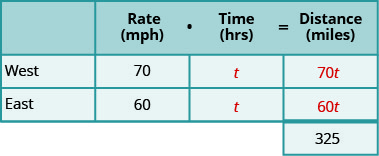
Step 4. Translate into an equation.
We need to find a relation between the distances in order to write an equation. Looking at the diagram, what is the relationship between the distance each of the trucks will travel? The distance traveled by the truck going west plus the distance traveled by the truck going east must add up to 325 miles. So we write:

Step 5. Solve the equation using good algebra techniques.
Now solve this equation. 70t+60t=325130t=325t=2.5
Step 6. Check the answer in the problem and make sure it makes sense.
Truck going West70 mph (2.5 hours)=175 milesTruck going East60 mph (2.5 hour)=150 miles_325 miles
Step 7. Answer the question with a complete sentence.It will take the truck 2.5 hours to be 325 miles apart.
Try It 3.5.8
Pierre and Monique leave their home in Portland at the same time. Pierre drives north on the turnpike at a speed of 75 miles per hour while Monique drives south at a speed of 68 miles per hour. How long will it take them to be 429 miles apart?
- Answer
-
3 hours
Try It 3.5.9
Thanh and Nhat leave their office in Sacramento at the same time. Thanh drives north on I-5 at a speed of 72 miles per hour. Nhat drives south on I-5 at a speed of 76 miles per hour. How long will it take them to be 330 miles apart?
- Answer
-
2.2 hours
MATCHING UNITS IN PROBLEMS
It is important to make sure the units match when we use the distance rate and time formula. For instance, if the rate is in miles per hour, then the time must be in hours.
Example 3.5.10
When Katie Mae walks to school, it takes her 30 minutes. If she rides her bike, it takes her 15 minutes. Her speed is three miles per hour faster when she rides her bike than when she walks. What are her walking speed and her speed riding her bike?
Solution
First, we draw a diagram that represents the situation to help us see what is happening.
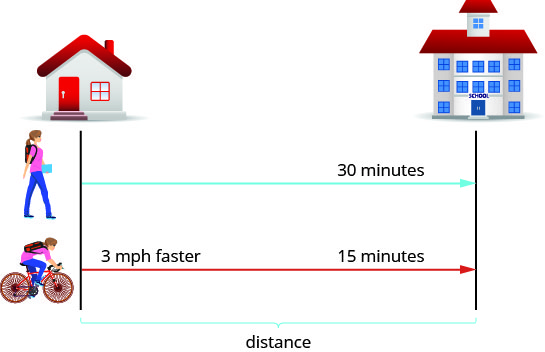
We are asked to find her speed walking and riding her bike. Let’s call her walking speed r. Since her biking speed is three miles per hour faster, we will call that speed r+3. We write the speeds in the chart.
The speed is in miles per hour, so we need to express the times in hours, too, in order for the units to be the same. Remember, one hour is 60 minutes. So:
30 minutes is 3060 or 12 hour 15 minutes is 1560 or 14 hour
Next, we multiply rate times time to fill in the distance column.
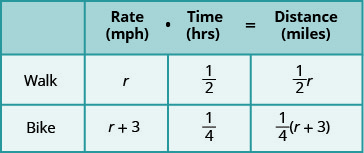
The equation will come from the fact that the distance from Katie Mae’s home to her school is the same whether she is walking or riding her bike.
So we say:
 |
|
| Translate into an equation. |  |
| Solve this equation. |  |
| Clear the fractions by multiplying by the LCD of all the fractions in the equation. |  |
| Simplify. |       6 mph (Katie Mae's biking speed) |
| Let's check if this works. Walk 3 mph (0.5 hour) = 1.5 miles Bike 6 mph (0.25 hour) = 1.5 miles |
|
| Yes, either way Katie Mae travels 1.5 miles to school. | Katie Mae’s walking speed is 3 mph. Her speed riding her bike is 6 mph. |
Try It 3.5.11
Suzy takes 50 minutes to hike uphill from the parking lot to the lookout tower. It takes her 30 minutes to hike back down to the parking lot. Her speed going downhill is 1.2 miles per hour faster than her speed going uphill. Find Suzy’s uphill and downhill speeds.
- Answer
-
uphill 1.8 mph, downhill three mph
Try It 3.5.12
Llewyn takes 45 minutes to drive his boat upstream from the dock to his favorite fishing spot. It takes him 30 minutes to drive the boat back downstream to the dock. The boat’s speed going downstream is four miles per hour faster than its speed going upstream. Find the boat’s upstream and downstream speeds.
- Answer
-
upstream 8 mph, downstream 12 mph
In the distance, rate, and time formula, time represents the actual amount of elapsed time (in hours, minutes, etc.). If a problem gives us starting and ending times as clock times, we must find the elapsed time in order to use the formula.
Example 3.5.13
Hamilton loves to travel to Las Vegas, 255 miles from his home in Orange County. On his last trip, he left his house at 2:00 pm. The first part of his trip was on congested city freeways. At 4:00 pm, the traffic cleared and he was able to drive through the desert at a speed 1.75 times as fast as when he drove in the congested area. He arrived in Las Vegas at 6:30 pm. How fast was he driving during each part of his trip?
Solution
A diagram will help us model this trip.

Next, we create a table to organize the information.
We know the total distance is 255 miles. We are looking for the rate of speed for each part of the trip. The rate in the desert is 1.75 times the rate in the city. If we let r= the rate in the city, then the rate in the desert is 1.75r.
The times here are given as clock times. Hamilton started from home at 2:00 pm and entered the desert at 4:30 pm. So he spent two hours driving the congested freeways in the city. Then he drove faster from 4:00 pm until 6:30 pm in the desert. So he drove 2.5 hours in the desert.
Now, we multiply the rates by the times.
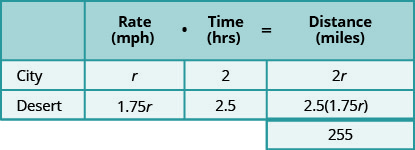
By looking at the diagram below, we can see that the sum of the distance driven in the city and the distance driven in the desert is 255 miles.
 |
|
| Translate into an equation. |  |
| Solve this equation. |        |
Check. |
|
| Hamilton drove 40 mph in the city and 70 mph in the desert. |
Try It 3.5.14
Cruz is training to compete in a triathlon. He left his house at 6:00 and ran until 7:30. Then he rode his bike until 9:45. He covered a total distance of 51 miles. His speed when biking was 1.6 times his speed when running. Find Cruz’s biking and running speeds.
- Answer
-
biking 16 mph, running 10 mph
Try It 3.5.15
Phuong left home on his bicycle at 10:00. He rode on the flat street until 11:15, then rode uphill until 11:45. He rode a total of 31 miles. His speed riding uphill was 0.6 times his speed on the flat street. Find his speed biking uphill and on the flat street.
- Answer
-
uphill 12 mph, flat street 20 mph
Key Concepts
- Distance, Rate, and Time
- D = rt where D = distance, r = rate, t = time
- Problem-Solving Strategy—Distance, Rate, and Time Applications
- Read the problem. Make sure all the words and ideas are understood.
Draw a diagram to illustrate what it happening.
Create a table to organize the information: Label the columns rate, time, distance. List the two scenarios. Write in the information you know. - Identify what we are looking for.
- Name what we are looking for. Choose a variable to represent that quantity.
Complete the chart.
Use variable expressions to represent that quantity in each row.
Multiply the rate times the time to get the distance. - Translate into an equation.
Restate the problem in one sentence with all the important information.
Then, translate the sentence into an equation. - Solve the equation using good algebra techniques.
- Check the answer in the problem and make sure it makes sense.
- Answer the question with a complete sentence.
- Read the problem. Make sure all the words and ideas are understood.







